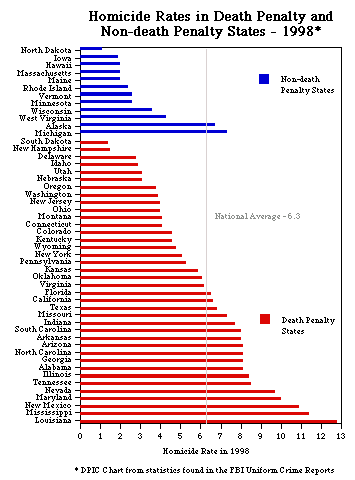Death In The States
As of now the death penalty is a
controversial issue
in the United States.
Many states feel that the death
penalty
is outdated and inhumane.
In the year of 1995, 16 states made
use of capital punishment, and now 38 states have jurisdiction with the
death penalty.
There are 12 states without capital
punishment.

(Source:Criminal Justice. opposing viewpoints.
73)
> This cartoon
illustrates how the death penalty is used as a deterrant to homicide. The
artist believe that if there were no such penalty as capital punishment,
the death rate would increase.
>
At the end of the last millennium, there were 3,539
men and 54
women on death row, from both federal government as well as state governments.
The state with the most inmates on death row was California, with 586,
with Texas following with 450, Florida by 371, and Pennsylvania by 238.
>
Of these prisoners on death row, 64% have a prior felony conviction and
8% have been convicted of homicide.
>
Out of 10 inmates, 4 have a criminal record at the time of their
capital offense, including 18% who are on parole, 10 % on probation,
and 11% with charges pending.
+
Race is also a topic of many discussions: some believe that blacks
and minorities are more likely to receive the death penalty than whites.
Other researches show that the race of the victim matters, more so than
the race of the defendants. Percentage-wise, the blacks have a higher number
of their population being executed.

Circumstances
~
The circumstances for receiving the death penalty are rape, 1st degree
murder, killing a cop or fire fighter, any multiple killing. Receiving
the death penalty mostly depends on if you committed any of the crime listed
with another felony. For instance, say you break into someone house; rape,
kill, and beat that person to death, you will get the death penalty in
any state that has reinstated the death penalty.
~
The circumstances for receiving the death penalty do not vary that much
from state to state. It's just that some states are using the death penalty
more often than others. If you were to kill someone in the South; you would
be more likely to receive the death penalty than if it was up North. Texas
do not protect against a giving the death penalty to a person that have
an IQ of a 7-year-old, and was the state that first try to give the death
penalty to a mentally retarded person.
There are five
different methods of execution......
 Electrocution
Electrocution
New york built the first electric
chair in 1888. Today electrocution is only used as a sole method
od execution in only two states Nebraska and Alabama. For execution
by the chair the inmate is usually shaved and strapped to a chair with
belts that cross the chest, grain, legs, and arms. A metal skullcap
shape electrode is attached to the scalp and forehead over a sponge moistened
with saline. the inmate is blindfold, a jolt of between 5000 and
2000 volts which last for about 30 seconds. The tissues swell, defecation
occurs, stream and smoke rises and there is a smell of burning.
 Firing
Squad
Firing
Squad
Firing squad is still a method
of execution in Utah and Idaho. For the execution the inmate is bound
to a chair with leather straps across the waist and the head. The
chair is surrounded by sandbags to absorb the inmates blood. Standing
20 feet away five shooters are armed, each shooter aims his rifle through
a slot in the canvas and fires at the inmate. The inmate dies as
a result of blood loss.
 Hanging
Hanging
In the 1890s hanging was the primary
method of execution used in the united states. This method is still
used in Delaware and Washington. For this execution the inmate is
weighed the day before, for practice using a sandbag with the same weight
(this usually takes about 45 minutes). The prisoner's hands and legs are
secured and they are blindfolded and the noose is placed around the neck,
with the knot placed behind the ear. The execution takes place when the
trapdoor is opened and the prisoner falls through. "The face becomes engorged,
the tongues protrudes, the eyes pop, the body defecates, and violent movement
of the limbs occur."
 Lethal
Injection
Lethal
Injection
Oklahoma became the first state
to adopt the lethal injection. Today 36 out of 38 states that have the
death penalty use this method. There are several heat monitors on the skin;
two needles are positioned, of which one is the backup. It is then inserted
into the usable veins, which is usually located in the inmate's arms. The
first is a harmless saline solution that started immediately. The inmate
is injected with the sodium thiopental which puts them the sleep and then
pancuronium bromide is injected to paralyze the inmate's entire muscle
system. Eventually the inmates stops screaming. The actual death occurs
from anesthetic overdose and respiratory cardiac arrest.
 Gas
Chamber
Gas
Chamber
Only five states authorize legal
gas as a method of execution. The inmate is strapped to a chair in an air
tight chamber. A stethoscope is attached to the inmate so the doctor, outside
the chamber, can pronounce the death. Everyone leaves the chamber, and
a signal is given to the executioner, who will then flick a lever that
releases crystals of sodium cyanide into the pail. A chemical reaction
turns it into hydrogen cyanide gas. The inmate is instructed to take deep
breaths to speed up the process. As a result of the gas, the eyes pop,
the skin turns purple hue and the victims begins to drool. The inmates
dies from cutting off the oxygen to the brain.
Crime Rates Between States

*
When Supreme Court reinstated the death penalty in 1976,some states chose
not to reinstate the capital punishment. Those that did not reinstate the
death penalty were not allowed to have a higher homicide rate than the
states that had reinstated the death penalty. 10 out of 12 states that
are without capital punishment, have homicide rates that are lower than
the national average.
*
Individual state analysis shows that states with the death penalty have
48% to 101% higher homicide rates than those without the penalty.
*
Another study also has shown that the threat of death does not deter most
criminals. The states with death penalty and the states without have similar,
symmetrical paths in the homicide rates. "I have inquired for most
of my adult life about studies that might show that the death penalty is
a deterrent. And I have not seen any research that would substantiate that
point," said Janet Reno.
The southern part of the country is more likely to give out the death penalty.
Over 80% of the death penalty given out occurred in the South. The Northeast
is responsible for less than 1%. The Southern states such as Alabama, Florida,
Mississippi, Louisiana, Georgia, and Texas are called "the death penalty
belt" because of the alacrity in which they sentence inmates to death.
In October of
1999, the south was the only region with the death rates over the national
average.

There are no plausible explanation
why the South has the majority of the death rates, but the high crime rates
may also be a factor.
It may also have something
to do with the weather: In Mexico, there are speed bumps
ever fifteen or so feet so that the drivers, being frustrated by the weather,
would not speed. Maybe in the South, where the weather is more humid and
hot, people are aggravated more easily and in a way, kill more easily.
*** THIS IS ONLY A SPECULATION***
Wrongful
Convictions
Many death row inmates have been released because of recent DNA testing,
recanted testimonies, and on the re-evaluation of the trial. At least 85
inmates
have released in the face of this new evidence. The question arises if
the death penalty is as moral as it is played in the media. There are new
technology that prove the inmates' innocence, where there were none before.
Who knows, that in the next twenty years, that some other gadgets would
come along and prove many more innocent?
The governor of Illinois, George Ryan, imposed a moratorium on death penalty
in January of 2000. 80 inmates have been released from death row since
1973. The annual average used to be 2.5. From 1993 to 2000, the annual
average rose to 4.6. One theory states that the governments have increased
the circumstances in which the death penalty is given, and thus more people,
innocent among them, are sentenced to death.
Also, the period of wait between being sentenced and being executed has
shortened to about eight years. Proving innocence takes a lot more time
than that, and more innocent people may be executed.
A major reason that so many innocents are convicted is because of the lawyers
assigned by the court. Some lawyers hired to represent defendants do not
care about the trial, as well as others who have the audacity to sleep
during court and are drunk half the time. Other lawyers have too much work
and are underpaid, and so cannot represent a person during the trial that
decides his life.
Another reason for wrongful conviction of innocent people are people.
58% of wrongful convictions were made because of mistakes in eyewitness
idnetification. 31% involved a false informant and only 17% were because
official misconduct.
New York and Illinois are the top of the list of known wrongful convictions,
whereas South Carolina only has four. Illinois has 42 innocent that were
convicted and sentenced to death row, and New York has 32. Texas and California
come third and fourth, with 27 and 21, respectively. Arizona, Arkansas,
Colorado, Kansas, Nebraska and Idaho are at the bottom with only 1 wrongful
conviction, each. There is no certain region where more errors are
made than others. Most of these inmates (170 cases) were found innocent
when the actual culprti was found, 103 cases in which DNA testing proved
their innocence, 15 in which their alibi was found to be solid, and ironically,
there were 8 cases where the victims were actually found alive.
Different states have different opinions about capital punishment. Not
all states use the death penalty, but the states that did reinstate the
death penalty have different circumstances that lead to the death penalty.
There are many questions about the death penalty. The morality, as well
as cost, deterrent quality, and possible errors create many doubts about
using the death penalty. Some research shows that the southern region use
capital punishment more frequently than other parts of the United States.
Other anti death penalty data have concluded that the death penalty is
dealt racially biased.
All methods of execution are inhumane and cruel. The majority of inmates
suffer horribly. Yet their crimes which led them to death row are equally,
if not more, horrible. Therefore, based on the research, there is no 'right'
answer to capital punishment.


 Electrocution
Electrocution
 Firing
Squad
Firing
Squad
 Hanging
Hanging
 Lethal
Injection
Lethal
Injection
 Gas
Chamber
Gas
Chamber

